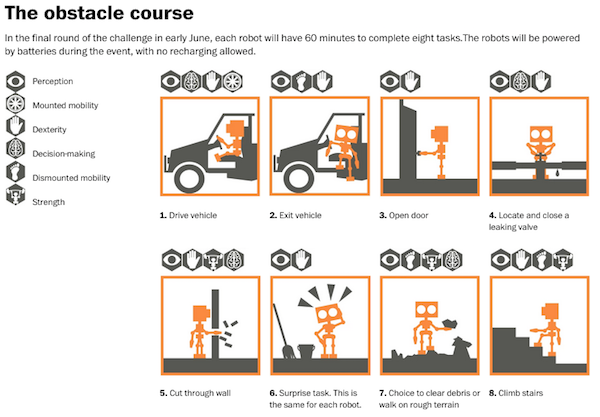Disaster Robot Competition Demonstrates Machine Advances
06/13/2015
A month ago, I wrote about the then-upcoming DARPA competition for robots, that had quite a demanding test for the machines (Humanoid Robot Competition Suggests Rapid Advance in Technology). DARPA is the Defense Advanced Research Projects Agency, an arm of the US Defense Department.
The diagram below shows the obstacle course of very challenging movements in the contest. The purpose of the competition was to foster the development of a disaster robot that could operate in a dangerous Fukushima-type environment, and the tasks reflect that.

Driving a car, closing valves and walking up stairs are at the edge of what free-standing robots can do these days. In fact, a number of the bots simply fell over, and someone put together a humorous video of gravity fails during the DARPA event:
Disaster-capable robots will certainly be an improvement over sending humans into radioactive sites, as happened during the Fukushima nuclear power plant meltdown following the 2011 earthquake and tsunami affecting Japan. However, the robots will likely be gradually introduced into fire fighting and some police work, which are well paid professions for humans precisely because the jobs are dangerous.
Despite the number of robots falling over, three machines completed the obstacle course successfully, which is quite impressive. The Korean Team Kaist won the $2 million first prize with its robot DRC-Hubo. The second-place finisher and winner of $1 million was Team IHMC Robotics of Pensacola, Florida with its robot Running Man. Coming in third and earning the $500,000 prize was Tartan Rescue of Pittsburgh and its robot CHIMP.
The video below of the DARPA event shows the state of the art in robots that can act in a disaster scenario that requires very advanced movements and balance. The science fiction future really is here, and society is about to be rocked. The most immediate challenge is the reduced need for human workers to produce goods and services, which is reflected now in the jobless recovery. It’s past time for more awareness and discussion among policy-makers. Certainly, first-world economies like the United States don’t need to be importing millions of immigrants, most of whom will end up being in the jobless underclass.
Transforming robot crowned the winner of DARPA’s Robotics Challenge, TheVerge, June 8, 2015Two-day finals in California saw robots wielding drills and driving cars
A South Korean team has won the $2 million top prize at the finals of DARPA’s Robotic Challenge (DRC) with a transforming bipedal bot that can scoot around on wheels in its knees. The winning design from Team KAIST managed to navigate DARPA’s obstacle course in under 45 minutes, successfully completing eight natural disaster-related tasks including walking over rubble, driving a car, tripping circuit breakers, and turning valves.
The DRC was set up after the 2011 Fukushima nuclear disaster in Japan, with the aim of accelerating the development of robots that can respond to man-made or natural disasters. Twenty-three teams competed in the finals, with a dozen entering from the US, and the rest traveling from countries including Germany, Italy, Japan, and Hong Kong.
The teams had been developing their robots for more than two years and have tried the challenges before. However, while previous trials gave the robots 30 minutes to complete each task, the two-day finals — staged in front of thousands of spectators in California — pushed the teams to complete all eight in less than an hour. Only three robots managed to successfully tackle them all, and the rest, well, they fell down a lot.
“These robots are big and made of lots of metal, and you might assume people seeing them would be filled with fear and anxiety,” said the event’s organizer Gill Pratt in a press statement. “But we heard groans of sympathy when those robots fell. And what did people do every time a robot scored a point? They cheered! It’s an extraordinary thing, and I think this is one of the biggest lessons from DRC — the potential for robots not only to perform technical tasks for us, but to help connect people to one another.”
Although Team KAIST took home the top prize, second place (and $1 million) went to Team IHMC Robotics, who used the Atlas robot built by Google-owned Boston Dynamics. Third place and $500,000 went to Team Tartan Rescue from Carnegie Mellon University, who finished with the top score at the end of the first day but were eventually overtaken.
“This is the end of the DARPA Robotics Challenge but only the beginning of a future in which robots can work alongside people to reduce the toll of disasters,” said DARPA director Arati Prabhakar in a press statement. “I am so proud of all the teams that participated and know that the community that the DRC has helped to catalyze will do great things in the years ahead.”
